Wednesday, September 27, 2006
Where Banjo lived and where Wolfman died
We headed out of Washington on September 24, headed to Coeur D’Alene, Id. and my friend C., where we found death and beauty in equal measures.
C. lived in Chico and Paradise for a long time, attending Chico State University for his business and finance degree, but he was raised in various places in Idaho. He used to tell us all these stories about the rugged, rural lifestyle, like doing e-brake 360s on icy driveways in pickup trucks. I had never been to Idaho, so I could only imagine what any of these stories actually looked like.
But finally we had arrived. After trekking across the part of eastern Washington that looks suspiciously like California’s central valley...
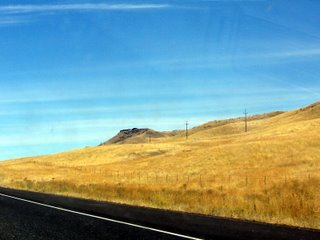
...we crossed the border and began to see the thick strands of towering pines, the immense, glassy lakes and huge, smoky hills.
The other thing we immediately began to see were housing developments. Farmland is being consumed at a rapid rate by huge, square colonies of homogeneous homes and scraggly deciduous saplings. This is a land tamed by loggers and farmers, where everybody hunts, where people own huge, lifted pickups and two quad runners just for that purpose. Still, somehow, the architects dictate that the ideal community is something like Levittown on steroids—flat tracts, square streets, tiny backyards. If anything is going to tame Idaho, it’s the housing. As we drove through Coeur D’Alene and its neighboring burgs, C. pointed out the potato and wheat fields that the farmers no longer own, cultivated by the developers until they feel like paving them over; the lumber mill quietly awaiting demolition to make way for more three-bedroom Shangri-Las.
This is a land where they race riding lawnmowers (that episode of "King of the Hill" is grounded in reality), where each town has its own amateur stock car league, where muzzleloader season leads into bowhunting season, which leads into rifle hunting season.
And they hate Californians. The last decade has seen a tremendous influx of the West Coasters seeking a more relaxed rural life (or perhaps just a decent price on a home larger than a breadbox).
“Lots of them, if they see you have a California license plate, will flip you off,” C. told us, glad that he got Idaho plates on his new car.
Moreover, Idaho is a conservative bastion, rife with George Bush bumper stickers. Likely they see Californians as liberal invaders.
Nonetheless, the Californians are coming—and millionaires from all around. Coeur D’Alene is refashioning itself into an upper-end resort town. It already boasts the longest floating boardwalk in the world—3,300 feet—on the shore of Lake Coeur D’Alene, where multi-hundred-thousand-dollar powerboats float tantalizingly close.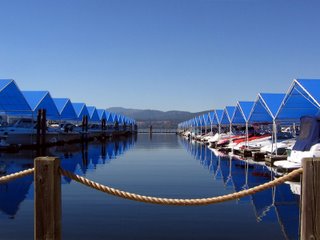
High-rise condominiums are shooting up downtown, and along a golf course with a legendary floating green, one developer is building two towering condo buildings which will offer units for $6 million apiece along with an agreement to pay an annual $160,000 membership fee for the course.
They’re numbers that boggle my mind. Obviously I don’t think like a millionaire, but the thought of spending more than the annual income of an upper-middle-class family so some teenager can open a fancy gate to let me onto a giant lawn makes me cringe. I will admit it: I don’t know the true nature of extravagance, but I still think I could put that $160,000 to better use each year.
Before we get to the Idaho wilderness, I should explain that 85 percent of C.'s stories involve death, murder, disfiguration, or some combination of the three. As part of his Coeur D'Alene tour, he showed us the Denny's where in 2005, authorities caught up with Joseph Edward Duncan III, who allegedly murdered a mother, a father and one of their sons before kidnapping their other son and daughter.
"He's right in there," C. said that day when we drove past the Kootenai County Public Safety Building, "in a holding cell awaiting trial."
"What's the holdup?" Val asked.
"They're trying to get an unbiased jury together," C. said, "which is hard, because everybody's heard of it. It was out as an Amber Alert when he kidnapped that girl. In fact, if you look around on the cars here, everyone's got a bumper sticker that says 'Kill Duncan.' That's what it's all about."
None of us said anything for a minute.
"He's going to die," C. said.
"He deserves to," I said.
"Yeah, but the thing is, he's not going to get a fair trial here."
"So why don't they move the trial?" Val asked.
"Nobody cares," C. said. "He knows what he did, and he didn't ask for it to be moved. He doesn't care, either."
After Monday’s tour of Coeur D’Alene, on Tuesday we drove north to explore a wilder Idaho where C. spent his early years. Highway 95 took us up across Lake Pen d’Oreille, a massive, cold lake deep enough for the Navy to allegedly test submarines.
In Sanpoint we saw the Litehouse Dressing Bleu Cheese Factory. C. told us how the famous dressing company got its start as a lakefront restaurant before its owners chose to focus just on the condiments.
We headed farther north, out past the towns with supermarkets and into country where the boomingest business is ranching and custom butchering. Out here the primary product seems to be old trucks. Every yard, lot and quarry is full of them.
The land here is beautiful, nestled between towering hills and the Cabinet Mountains, bordering lakes and valleys, all clear and pristine. But it's not fancy living.C. summed it up, classified ad-style: "Beautiful doublewide, on 100 acres, lakeside view. Cinder blocks for your car included."
And we hadn't even reached Clark Fork yet, the dusty little town where C. attended high school. On our way into town we passed a squat stone cabin with a tin roof flying a tattered Confederate flag.
"See that?" C. said. "That's where a former Hell's Angel named Dirty Don lives." Dirty Don, it seems, shot his wife's lover in a bar called Out of Bounds.
"We always called it Out of Bullets," C. said. Ironic.
C. also went to school with Dirty Don's children. DD's son, Banjo (that's not a nickname), dropped out of high school when he was a freshman. Now, C. explained, he drives around town in a huge pickup sporting a thousand-pound homemade wooden bumper with the words "fuck you" painted on it.
As a teenager, C. and his friends like to make acetylene bombs using the welding gas, oxygen and garbage bags.
"You had to walk real carefully with it, because any static spark could set it off," he said. "Then you'd light the fuse and run like hell, because if it went off when you're too close, it could destroy your eardrums."
It's an attempt to be big against the inconceivable bigness of the wilderness. You're big, you're bad. You make the mountains ring with your sound. You make tourists cringe when they see your truck.
Clark Fork is a small, remote town. C. remembers one incident that brought everyone together.
"This guy went missing in the woods, and the entire town went out to search for him," C. said. "We did a grid search of this entire mountain. The whole football team went out there. My dad was on his weekend, and he spent days up there. Finally, after six days, they found him."
"Alive?" Val asked?"Nah," C. said. "He tripped, fell off a cliff and landed on his head."
As we continued on, C. told us we were driving on one of the most dangerous highways in the country. As we passed homemade cross after homemade cross, I saw what he meant. One of the most notable we saw was nestled along the base of a jutting cliff. It was an ankh placed in memory of "WOLFMAN."
Death was even more abundant in Montana, where the state evidently erects a small white cross on a post for each person who died in an accident on the highway. We passed these with alarming frequency, counting seven little crosses in one particularly deadly mile.
“When we were little, we used to count these instead of slugbugs,” C. said, “since there’s no VW Beetles out here.”
What northern Idaho and Montana both have is an almost sickening abundance of breathtaking rugged vistas here. I could photograph every bend in the road. But then we’d never get to whatever sight we’re actually traveling for. I think I ought to have a more sophisticated camera. I think I should have taken photography courses so I might know how to exploit the riches pouring through my viewfinder. But as it stands, I have limited time, limited equipment and limited knowledge. Bear with us, and maybe the thought that it’s Val or me behind the shutter will compensate for the lack of originality or the iffy composition.We drove to see the Ross Creek Cedars, an incongruous forest of the ancient trees amid the pines.
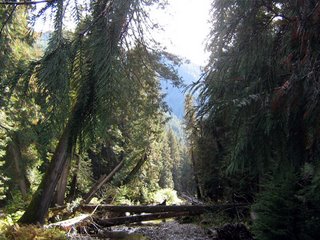
C. remembered visiting them as an elementary school student.
"John Bidwell must have been here," he said.
"Was Bidwell a big Cedar Guy?" I asked.
"No, but he planted every non-native plant under the sun."
After we wandered around in the forest and took a bunch of totally artistic pictures that all turned out like blurred crap, we got back in the car and drove up to what C. called the swinging bridge. This turned out to be Kootenai Falls, a breathtaking view of the Kootenai River along the railroad tracks.
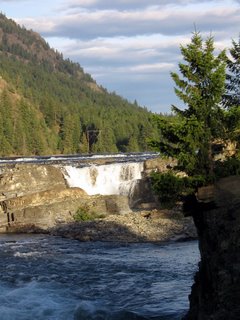
As a bonus, we got to watch a pair of kayakers fight the current and dodge their way through the foam, howling like wild men the whole time.
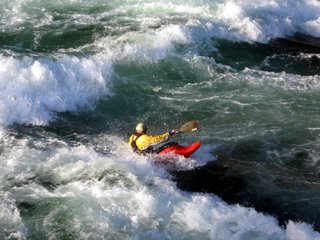
We followed the kayakers downriver, walking on a trail along the cliffside until we came to the swinging bridge C. was talking about. It was a cable suspension bridge spanning the sheer cliffsides of the Kootenai. As we approached, we noticed a sign that said "5 persons maximum." Not exactly encouraging. I hoped Val, C. and I weighed less than the theoretical persons the engineers had calculated for.
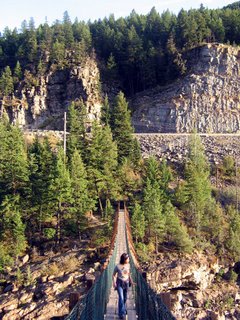
We did.
After walking back across (nervous the whole time about one of us tripping and sending us teetering over the waist-high fencing), we began the drive back to Coeur D'Alene, counting the tiny roadside crosses in the fading light.
